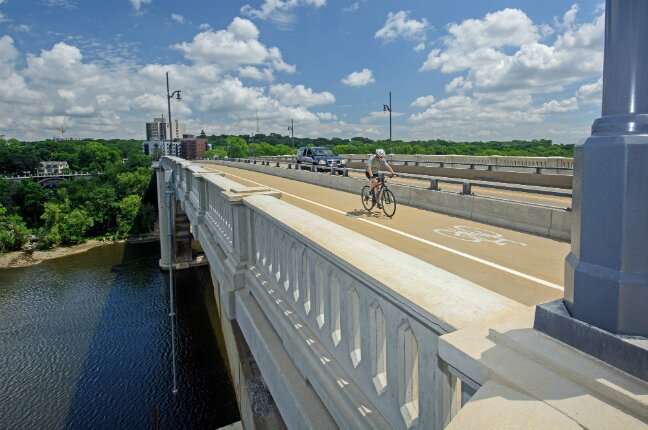Investments in biking routes improve access to jobs in US metros

First-of-its-kind research from the Accessibility Observatory at the University of Minnesota ranks the 50 largest (by population) metropolitan areas in the United States for connecting workers with jobs via bicycle.
The new rankings in Access Across America: Biking 2017 are part of a national pooled-fund study that began in 2013 and focuses on accessibility. Accessibility, which examines both land use and transportation systems, measures how many destinations, such as jobs, can be reached in a given time.
"This new data provides a baseline to evaluate how well a metro area is facilitating access to jobs by bicycle from year to year," said Andrew Owen, director of the Observatory. "Bike commuting is a cost-effective, healthy, and environmentally sustainable alternative to being stuck in traffic. State departments of transportation, metropolitan planning organizations, and local agencies can use our findings to better coordinate investments in bicycle facilities with the location of jobs and housing to improve job accessibility by bike."
The study incorporates traffic stress and cycling comfort in its evaluation of access to destinations by bicycle. According to the study, low-stress routes are separated bike lanes and paths. Medium-stress routes include all bike infrastructure—low-stress facilities plus on-street unprotected bike lanes, certain shared lanes, and mixing with traffic on some non-arterial streets.
Many cities exhibit different rankings between their low-stress and medium-stress job accessibility metrics. For example, Philadelphia places 5th by low-stress access, but only 13th by medium-stress access. Minneapolis–St. Paul places 12th by low-stress access and 7th by medium-stress access. Generally, residents in Philadelphia who are only willing to bike on low-stress facilities reach more jobs than those on low-stress routes in Minneapolis. However, residents in Minneapolis willing to travel on all bicycle facilities reach more jobs than those in Philadelphia.
The metropolitan areas that perform the best when comparing medium-stress access to the maximum-possible bike access are Minneapolis–St. Paul, San Francisco, and Portland. All have bicycle networks that, on average, allow their residents to reach more than 74 percent of the job opportunities theoretically available to cyclists (if all routes felt as safe as an off-street path).
Since 2010, the number of bicycle commuters nationwide has increased nearly 22 percent. "Though biking is used for less than one percent of commuting trips in the United States, biking infrastructure investments are much more cost-effective at providing access to jobs than infrastructure investments to support automobiles," Owen said. "Ultimately, our findings give policymakers and planners more options to improve transportation performance goals related to congestion, reliability and sustainability, as well as increased access to jobs."
More information: Access Across America: Biking 2017 - access.umn.edu/research/america/biking/2017/
Provided by University of Minnesota



















